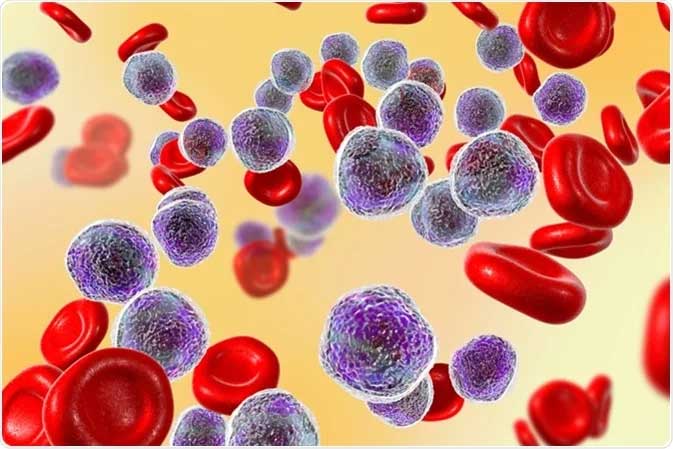What is leukemia?
Leukemia is a progressive blood cancer characterized by the growth of abnormal and immature blood cells in the system. This origin and growth of cells take place in the tissues and organs where blood cells such as the spleen and bone marrow.
The term is derived from the Greek words ‘leukos’ meaning white and ‘haima’ meaning blood. As it forms in the blood, a fluid connective tissue, it cannot be diagnosed using conventional imaging techniques such as CT scans and X-rays. No tumor is formed generally.
There are different types of leukemia. A few of them are common among children or adolescent patients. The rest are witnessed among adult patients. The treatment of leukemia depends on its type, rate of progression and other associate factors.
How leukemia develops
As mentioned earlier, leukemia is a type of blood cancer. It generally develops in the sites of origin of blood cells such as bone marrow. It is a soft tissue present inside the bones. In most cases, leukemia can result in the formation of spleen cancer. It is an organ that filters and stores blood and produces white blood cells.
To understand the types of leukemia, we need to define the stages of blood cell development. First, let us classify the mature blood cells.
• Red blood cells
These cells are the most abundant in number. They are disc-shaped cells filled with hemoglobin, a red-colored pigment that carries oxygen and carbon dioxide and helps in the exchanges of respiratory gases.
• White blood cells
These cells are the frontline warriors that constitute the immunity system of a person. They together fight infections by killing pathogens.
• Platelets
These are tiny disc-shaped pieces of large cells present in blood that help in coagulation and healing of wounds. These cell pieces can also be found in the spleen.
In the beginning, these cells remain in the form of hematopoietic stem cells. These primary cells develop into myeloid or lymphoid cells in the next stage. If the normal development process is continued, here is what these primary cells will form in the next stage.
- Myeloid cells will gradually develop into red blood cells (RBCs), platelets and white blood cells (eosinophils, basophils, and neutrophils)
- Lymphoid cells will develop into lymphocytes. They are also a type of WBCs and other natural killer cells.
When an individual develops leukemia, one of the developing cells begins multiplying abruptly. This abnormal multiplication and growth of such cells results in a type of leukemia and the cells are called leukemic cells. They begin to cover the spaces inside the bone marrow. Eventually, these leukemic cells crowd out the normal cells that are trying to develop into RMCs, WBCs, and platelets.
How leukemia is diagnosed?
As mentioned earlier, leukemia is a type of blood cancer that generally does not form a tumor anywhere. Hence, its detection is only possible when a complete blood count (CBC) test is done. It is a type of blood test that provides a detailed count of all the cellular components of a person’s blood.
Here is how the diagnosis of leukemia is done in a stepwise manner.
1. Physical exam
The symptoms of leukemia are quite similar to flu and other common diseases. It is hard to conclude leukemia with those symptoms. However, recurrent fever, extreme fatigue, exhaustion, weight loss, pale skin, bone pain, joint pain, easy bleeding and bruising, etc are frequent and consistent then doctors recommend a vivid physical exam.
A physician will check for swollen lymph glands, enlarged spleen, enlarged liver, bleeding from gums, swelling, etc. Leukemia can also cause brown, dark-red, or purple rashes.
2. CBC blood test
If the physician suspects anything, he will prescribe a CBC blood test. This test will reveal the exact count of all blood cells. There are different types of leukemia. For instance, acute leukemia causes an abnormal increase in cell count. On the contrary, chronic lymphocytic leukemia, chronic myeloid leukemia, and small lymphocytic leukemia can result in closer to normal blood count.
3. Bone marrow biopsy
This is an aspiration technique where an invasive procedure is involved to secure a bone marrow sample. The cells in the marrow sample are tested for abnormality.
4. Imagine techniques
If the experts are suspecting a higher spread of leukemia, they prescribe imaging scans to detect the affected bones, tissues, and organs.
Regular blood work to check the progress
When detected, the patient is directed to take regular blood tests. It is done to check whether the medicines and other treatment approaches are effective to control the spread. For this, doctors order CBC tests at a regular interval considering the type of leukemia and the condition of a patient. This is what leukemia is and how it is diagnosed using blood tests and the treatment is planned accordingly.







